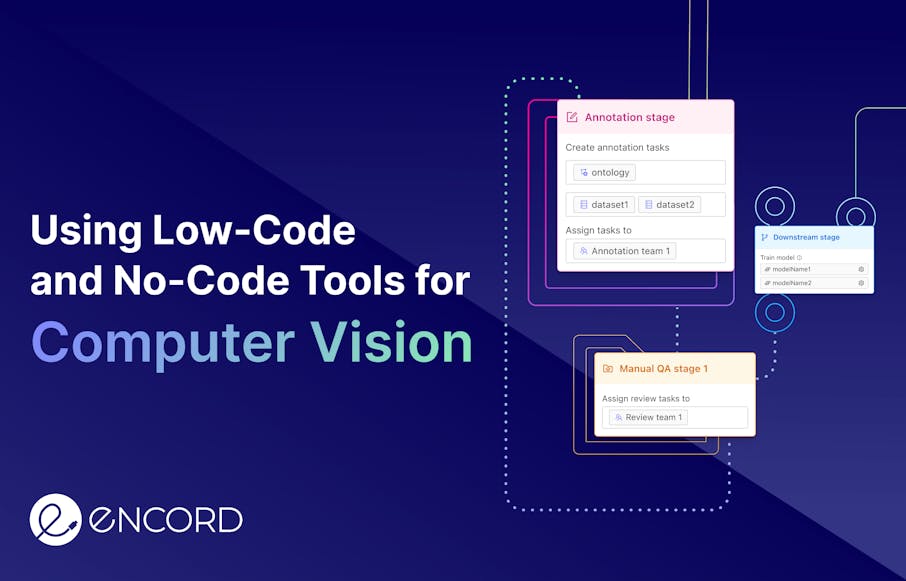Contents
What is a No-Code Computer Vision Platform?
No-Code vs. Low-Code
The Benefits of Accelerated AI Model Training and Deployment
Accelerate AI Data Annotation With Active Learning for Computer Vision
Encord Blog
How to Use Low-Code and No-Code Tools for Computer Vision

The use of low-code and no-code environments, platforms, and active learning tools for computer vision is on the rise.
Until recently, the only way to deploy software and algorithms for computer vision was through open-source applications or subscribing to proprietary tools (e.g., Software as a Service (SaaS) solutions), such as Encord.
Now there’s a third option: low-code and no-code active learning platforms for active learning computer vision projects. You can build active learning tools and applications with zero technical knowledge and expertise with no-code solutions.
Low-code solutions are similar, although a small amount of coding knowledge and experience is often useful.
This article compares and contrasts no-code and low-code computer vision platforms. We look at why businesses and organizations are keen to deploy no-code and low-code software for computer vision projects.
What is a No-Code Computer Vision Platform?
Since the pandemic, the no-code and low-code development market has experienced even faster growth. In 2020, the market was worth over $10 billion and is expected to reach $94 billion in 2028, with a compound annual growth rate (CAGR) of 31.6%.
At the time, businesses didn’t have the resources or budgets to commit to software development projects. So, one of the best solutions was to have teams without coding skills build websites, software, and apps, and the best way to achieve this was using no-code and low-code development platforms.
No-code and low-code solutions were already popular in several sectors. However, given the time and resource limitations the pandemic imposed on organizations, it became necessary to look for solutions many wouldn’t have considered previously. Fortunately, the low-code/no-code software market was already active, with thousands of products and solutions on the market already. Many of which could be adapted and used for computer vision projects.
For computer vision (CV) and machine learning (ML) projects, software developed using no-code tools means that people without coding experience can design and deploy them. Similarly, leveraging mobile app development services can streamline creating user-friendly applications, enhancing the overall project efficacy and customer interaction. There are numerous benefits to this, as we’ll soon cover.
No-Code vs. Low-Code
No-code and low-code software and development platforms are very similar.
For practical purposes, the only significant difference is that low-code solutions require some coding knowledge. Whereas no-code are usually drag-and-drop interfaces. Unlike no-code website builders, non-technical people can simply select the features they want and move them into position.
Organizations and teams building applications for computer vision projects can use these no-code and low-code app development platforms to accelerate AI (artificial intelligence) model training and deployment. Both types of solutions reduce the go-to-market time for new applications and make it easier for ML and data ops teams to start training computer vision models faster.
The Benefits of Accelerated AI Model Training and Deployment
Training and deploying an AI model involves several stages, including image or video-baseddata annotation work.
Depending on your sector or specific use case ⏤ healthcare, retail, aerospace, defense, etc. ⏤ you might not be able to find the right tools for the project. It might be quicker to build your own; however, you don’t want to spend 9 to 12 months (or more) and 6 figures to achieve this.
A more sensible, cost, and time-effective solution would be to use a low-code or no-code development platform to accelerate AI model training and development.
Here are five reasons you might want to use a low-code or no-code platform for your next computer vision project:
Collaborative, Accessible Tools for Teams
As a rule, low-code/no-code tools are easy to use and more accessible for non-technical teams. Making them more collaborative when non-technical people are involved in computer vision projects, such as operations, marketing, sales, or medical professionals in the healthcare sector.
Because these solutions often have pre-built AI models within them, there are already basic tasks many can perform before integrating low-code/no-code tools with more advanced CV models.
Accelerated Time-to-Market
With any computer vision project, the time-to-market when customized coding is needed within datasets, model development, or active learning platforms. When you use a low-code/no-code alternative, the time-to-market accelerates.
One of the reasons for this is pre-built AI models and ready-made datasets templates. You might need to make some customizations for your project and use case, but doing so is easier when using low-code/no-code tools.
Lower Costs, Better Results
Because of the time and cost involved when implementing and deploying computer vision projects, anything you can do to reduce costs and improve results is an investment worth making. Naturally, developers and data science engineers aren’t necessary for low-code/no-code tools so this approach will save time and money.
The more functionality you can automate, the quicker you can train and deploy an active learning computer vision model. Low-code and no-code development platforms make it easier for those managing computer vision projects to accelerate and automate numerous manual aspects of project workflows.
Easier Diagnostics and Debugging
As we’ve mentioned in a previous post, “Debugging deep learning models can be a complex and challenging task.”
Debugging a computer vision model is very challenging. “The more advanced the neural network selected for the model, the more complex the issues it can have,” making debugging a headache.
With low-code/no-code tools, it’s somewhat easier to debug models or the software that AI-based models run because there aren’t thousands of lines of code to scan. Making it significantly easier to quickly identify, diagnose, and debug the model when something isn’t working.
Certified Data Security
One of the final advantages is that low-code/no-code tools have high levels of data security built-in.
Data security is mission-critical for many computer vision projects, especially when the datasets a model is being trained on are potentially sensitive, such as healthcare and medical images. For data compliance and security reasons, the last thing you can afford is a data breach or leak. It could affect the entire project, potentially wasting months of work.
Having a computer vision platform that’s HIPAA and SOC 2 compliant is a distinct advantage, especially when you’re handling sensitive data.
Accelerate AI Data Annotation With Active Learning for Computer Vision
One of the most cost and time-effective ways to accelerate computer vision machine learning projects simply is by using Encord or Encord Active.
Encord also has an Annotator Training Module that helps leading AI companies quickly bring their annotator team up to speed and improve the quality of annotations created. Whatever tool(s) you deploy or software you need to accelerate model development, training, deployment, and iterative learning, Encord has everything you need.
Depending on your project and use cases, you can use aspects of our toolkit that don’t require coding skills, making them as easy to use as SaaS tools or low-code/no-code solutions. Most non-technical people feel completely comfortable using Encord, and others can implement anything that requires more technical skills on the team.
At Encord, our active learning platform for computer vision is used by a wide range of sectors - including healthcare, manufacturing, utilities, and smart cities - to annotate human pose estimation videos and accelerate their computer vision model development.
Encord is a comprehensive AI-assisted platform for collaboratively annotating data, orchestrating active learning pipelines, fixing dataset errors, and diagnosing model errors & biases. Try it for free today.
Data infrastructure for multimodal AI
Click around the platform to see the product in action.

Written by

Frederik Hvilshøj
Explore our products


